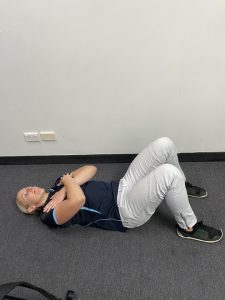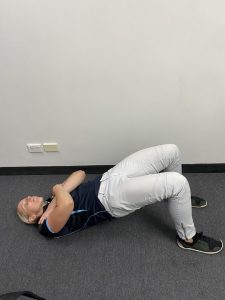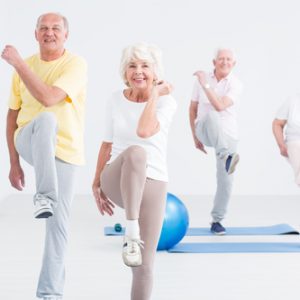Let’s face it. Sit-ups are not the best “core exercise” for everyone let alone for anyone. We often get asked about the best exercises to strengthen the “core” so, without further ado, here are the top 5 exercises that are appropriate for seniors and some ways to make them easier or harder:
- Reverse lowers
A sit-up exercise involves shortening or curling the trunk while the muscle is contracting. This action is only performed a few times throughout the day. The opposite movement – from a curled up position to an extended position – is done far more frequently e.g. think about lifting something up! This is where the reverse lower has more relevance for day-to-day life.
How do I perform the exercise?
To perform this exercise correctly, sit towards the front of a chair and keep your trunk stiff as you lower down to open the
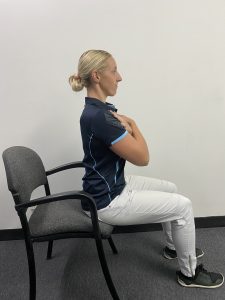
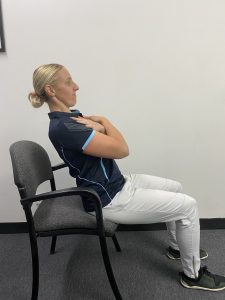 space at the front of the hips. Pause at the end position and then return to the starting position.
space at the front of the hips. Pause at the end position and then return to the starting position.
How to make it easier?
Either shorten the distance that you move, or you can perform fewer repetitions.
How to make it harder?
Try leaning further back, pausing in the end position for longer, keeping one leg in the air while you lean back, extending the arms overhead while you lean back or performing more repetitions.
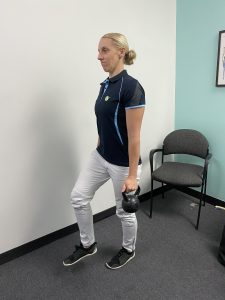
- Single arm carry
Carrying a weight seems simple enough, however its benefit to core strength and in particular to the muscles that form the sides of the trunk is often underestimated. It is also an activity that we do most if not all days.
How do I perform the exercise?
Position yourself in an area where you can see your reflection. Use a weight (can be any household item such as a drink container or a paint can) that is heavy enough that you instinctively want to lean towards it. Fight the urge to lean and concentrate on keeping the hips
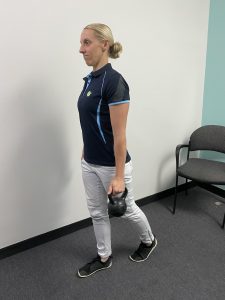
and shoulders level as you walk slow and steady paces in front of you.
How to make it easier?
You can simply choose a lighter object.
How to make it harder?
Choose a heavier weight, position the weight over the shoulder instead of by your side, or walk heel to toe (if safe to do so).
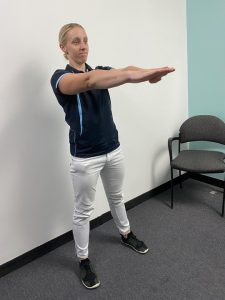
- Squat
Yes you read this correctly! While it is not commonly thought of as a “core strengthening” exercise, the squat exercise is great for recruiting the trunk muscles. Again, it is also an activity that we perform almost every day!
How do I perform the exercise?
To perform this exercise correctly, position yourself in front of a chair or bench. This is more for safety – if you feel you don’t need it, you can do so without. Have your feet hip-width distance apart with toes pointing forward. Start to push your
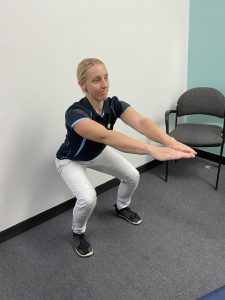
bottom back towards the wall/chair behind you, at the same time bending at the knees. Come as low as you feel comfortable, then squeeze your bottom and return to standing position. Make sure your knees don’t collapse in towards each other and your weight remains even throughout your feet, not pushing onto your toes.
How do I make it easier?
To make this exercise easier perform less repetitions, use a chair for support and don’t bend down too far.
How do I make it harder?
To make this exercise more challenging hold a weight in front while performing the squat, pause or pulse at the bottom of the movement, increase the number of repetitions you perform and hold a weight in one hand while trying to remain straight.
- Bird dog
We are not too sure what the people who thought of this exercise name were thinking. Names aside, the bird dog has been shown to be a very good exercise to strengthen the posterior trunk muscles (the “back” core muscles). It also has the added benefit of achieving this without putting substantial compression force through the spine.
How do I perform the exercise?
Below we have shown both the floor and raised surface version of this exercise – you can choose whichever you feel comfortable with. Position yourself with your hands flat on the floor/chair – make sure your wrists are below your shoulders. Brace your core muscles by drawing your bellybutton in towards your spine. Lift one arm up in front of you, and the opposite side leg back behind you, using your core muscles to keep your hips still and balanced.
Keep control of the movement so you don’t tip over! Lower the arm and leg back to the floor then lift the opposite arm and leg to continue in an alternating movement.
How do I make it easier?
To make this exercise easier, simply move one limb at a time or perform the exercise in a more upright position.
How do I make it harder?
To make this exercise more challenging, increase the difficulty of the base position you are using (ie use a kneeling plank), increase the time you are holding the position, draw a shape with the arm/leg at the end of the reach, or perform more repetitions.
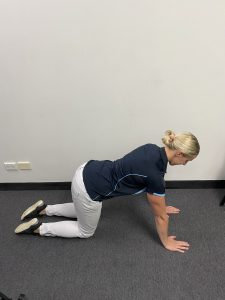
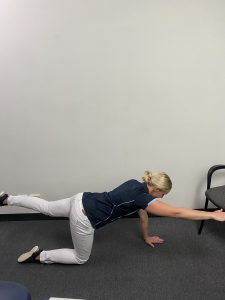
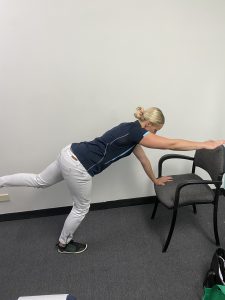
- Hip bridge
Lucky last is the hip bridge, which is a great way of training the coordinated strength of the muscles on all sides of the trunk and including those (often lazy) glute muscles. It is also easy to modify to replicate the demands of walking.
How do I perform this exercise?
To perform this exercise correctly, lie flat on your back – either on a bed (make sure it is not too soft) or on the floor. Keep your feet flat on the bed/floor and bend at your knees. Push your heels down into the bed/floor, squeeze your glutes (draw your ‘sit bones’ together), brace your core and push your hips into the air. Make sure you don’t overarch through your lower back and don’t let your knees rock together. Hold for a few seconds then slowly lower your hips back to the bed. Your core and glutes shoulder work together to keep your trunk and hips strong through the movement.
How do I make it harder?
To make this exercise more difficult lift one leg while performing the same movement, keep your arms crossed over your chest, extend a weight overhead at the same time, perform all repetitions without rest, hold the top position for longer and perform more repetitions.
